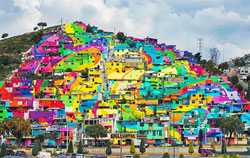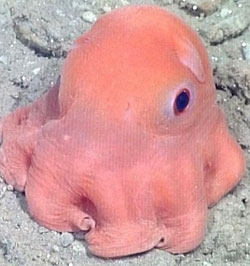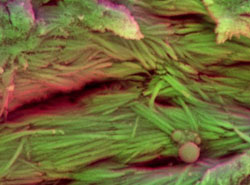Diana Kupke Writes

Eighteenth Archive
Items from 2 May to 31 August 2015
23 July to 31 August 2015

Image by Lin and Lin Gallery
Chinese artist Cao Hui changes everyday items into flesh and guts. Items including an armchair, gloves and a suitcase are shown as flesh through the use of resin and fibres.
Cute frog

This minute frog has just been discovered in the Andes in Peru. Called Noblella madreselva, it lives in the forest near Cusco, Peru. These frogs live on the forest floor and are active during daylight hours.
Biologist, Vanessa Uscapi, from the National University of Saint Anthony the Abbot in Cusco, Peru, chose the name madreselva to honor conservation initiatives in the region: The word means mother jungle.
Walk the Tortoise

If you visit Tokyo you may see Mitani Hisao walking his tortoise, slowly! Now 62, this gentleman bought a baby tortoise 19 years ago and called him Bon-chan. Today the tortoise weighs 154 pounds. They walk for several hours two or three times a week. Bon-chan has a variety of outfits.
Rainbow Village

Above is the Mexican village, Palmitas, which was turned into a rainbow by a youth organisation of street artists, called Germen Crew. The group painted all 200 houses in this low income area.
29 June to 23 July 2015

Old computers are put to an interesting use by UK artist, Julie Alice Chappell who turns components into a range of insects.

Photo: Steve Messam
If you have a lot of waste paper you could always make a bridge. Steve Messam used 20,000 sheets of red paper to make the bridge shown above. You also need cages filled with stones at each end and a wooden form to shape the structure. The bridge crosses a stream in Cumbria in the UK.

Is this a new species? No, this is an Angora rabbit called Wally who lives with his owner, Molly, in Massachusetts.

This truck is a sculpture, by Erin Wurm, which is in Karlsruhe, German. Recently it was issued with a parking ticket and the ensuing furore gave great impetus to the 300 year celebration of the city.

This hut on stilts is only 2.5 m by 2.5 m but it provides an English writer with the perfect place to perfect his craft. The hut, designed by Nozomi Nakabayashi, can be found in Dorset. The stilts are reclaimed telephone poles while the cladding is made of western red cedar and douglas fir.
1 June to 28 June 2015

It can be very cold in Michigan where photographer, Hope Carter, took the photograph above and below. When the thermometer registered minus nine degrees centigrade she ran outside armed with bubble solution and her camera. She blew a number of bubbles and when one landed intact she took a photograph as the crystals spread inside.

Not what you think!

This man is not an alcoholic with a huge thirst! The item Eric Adjetey Anang is standing beside is actually a coffin! Based in Ghana, Kane Kwei Coffins, produce an amazing range of coffins which are designed to represent the life of the person who has died. The range of coffins include a lobster, guitar, bottle of talcum powder and a pen. The fantasy coffins appear to have begun when Eric's grandfather, Seth Kane Kwei, made a coffin in the 1940's, a carved palanquin for a chieftan. When his mother died she was buried in a coffin shaped like an aeroplane. The workshop produces 300 coffins each year of which 20 percent are exported.
Simply Adorable

This delightful octopus has been known to exist since the 1990's. Stephanie Bush, who is employed by the Monterey Bay Aquarium Research Institute, gave it the name of Opisthoteuthis adorabilis because she thought it was very cute.

Photograph by Sergio Bertazzo
What is it? Fossil fragments, which were dug up more than 100 years ago, and are in poor condition, are used by researchers. Two researchers in London amazingly found traces of soft tissue and red blood cells in the ribs of a dinosaur. The fossil fragment is believed to be 75 million years old.
22 May to 31 May 2015

The Daily Mercury in Mackay has a large advertisement which runs frequently saying one million locals search their site every week. A story in the Daily Mercury on May 20 says the population of the region is 123,383. Some very strange arithmetic going on there.
Beautiful moonfish

Nick Wegner, a biologist with NOAA Fisheries, holds a moonfish, or opah, the first and only fully warm-blooded fish. This enables it to live many hundreds of feet below the surface of the ocean.
Other fish, swimming at great depths, are slow in order to conserve energy, they don't chase their prey but ambush them. The moonfish however, because of its warm blood, can swim fast, reacts quickly and has better vision.Tuna and some sharks can warm their muscles, which boosts their swimming performance but their organs cool quickly so they are forced to swim up to shallow depths. With the moonfish, fatty tissue around their hearts, muscles and gills generates internal heat which insulates them and enables them to move at depth in cold water.
Moon Hoon Design

This building, a guest house, on the island of Jeju, Korea, was designed by Moon Hoon
It was designed for a limited budget but nonetheless has three storeys and includes tourist accommodation, a coffee shop, a library, and a private area for the owners. A viewing platform is raised high above the building which provide views of moutains and the sea. A central atrium sends light flowing.
Beautiful Mosaic

During the past eight years, excavations at Zeugma, Turkey, have unearthed more than 2000 houses plus numerous mosaics. Excavations were only possible since 2000 as prior to that date the old city was submerged.
2 May to 21 May 2015

This beautiful octopus is by Scott Bisson, an Oregon glass artist. He became interested in glass at high school and continued his training with a variety of mentors in the USA and Italy. He has worked with glass for almost twenty years and his sculptures can be found in 80 US galleries. Scott also made the delightful frog below.

Poor Books!

Food Cubes

The photograph above is of cubes made from 98 unprocessed foodstuff which was commissioned for a Dutch food newspaper. Design studio Lernert & Sander was responsible for the photograph which is now available through a limited edition for 500 pounds. Identification of the items is not a simple matter.

A graphic designer who had stage 3 Hodgkin's lymphoma has come up with a series of cards which are appropriate to be given to people who are seriously ill. Emily McDowell was only 24 when she was diagnosed. Following treatment she has been free of cancer for 14 years.
She said, "The most difficult part of my illness wasn't losing my hair, or being erroneously called sir by Starbucks baristas, or sickness from chemo. It was the loneliness and isolation I felt when many of my close friends and family members disappeared because they didn't know what to say, or said the absolute wrong thing without realizing it."
Empathy cards 19th archive 17th archive